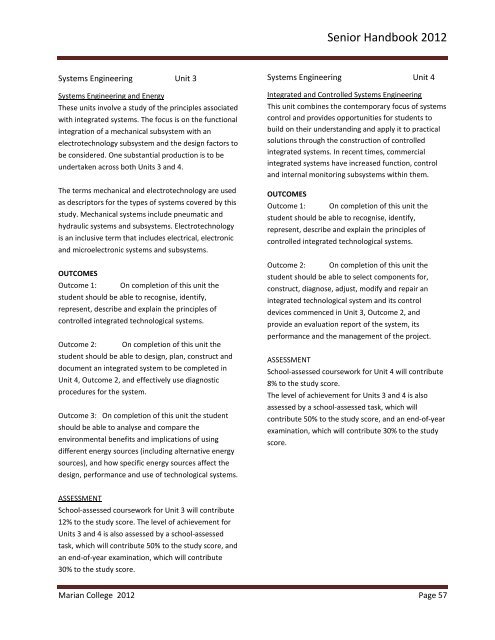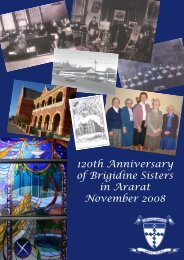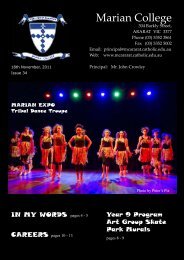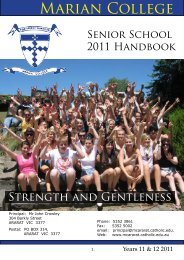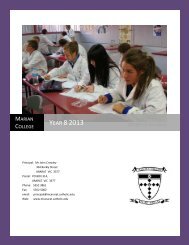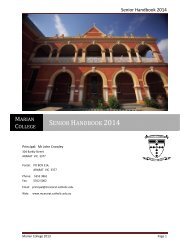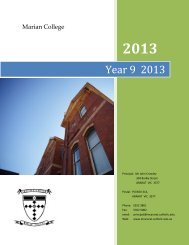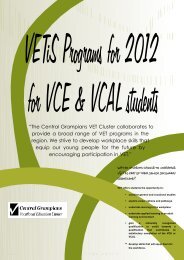Senior Handbook 2012 - Marian College
Senior Handbook 2012 - Marian College
Senior Handbook 2012 - Marian College
Create successful ePaper yourself
Turn your PDF publications into a flip-book with our unique Google optimized e-Paper software.
<strong>Senior</strong> <strong>Handbook</strong> <strong>2012</strong><br />
Systems Engineering Unit 3<br />
Systems Engineering and Energy<br />
These units involve a study of the principles associated<br />
with integrated systems. The focus is on the functional<br />
integration of a mechanical subsystem with an<br />
electrotechnology subsystem and the design factors to<br />
be considered. One substantial production is to be<br />
undertaken across both Units 3 and 4.<br />
The terms mechanical and electrotechnology are used<br />
as descriptors for the types of systems covered by this<br />
study. Mechanical systems include pneumatic and<br />
hydraulic systems and subsystems. Electrotechnology<br />
is an inclusive term that includes electrical, electronic<br />
and microelectronic systems and subsystems.<br />
OUTCOMES<br />
Outcome 1: On completion of this unit the<br />
student should be able to recognise, identify,<br />
represent, describe and explain the principles of<br />
controlled integrated technological systems.<br />
Outcome 2: On completion of this unit the<br />
student should be able to design, plan, construct and<br />
document an integrated system to be completed in<br />
Unit 4, Outcome 2, and effectively use diagnostic<br />
procedures for the system.<br />
Outcome 3: On completion of this unit the student<br />
should be able to analyse and compare the<br />
environmental benefits and implications of using<br />
different energy sources (including alternative energy<br />
sources), and how specific energy sources affect the<br />
design, performance and use of technological systems.<br />
Systems Engineering Unit 4<br />
Integrated and Controlled Systems Engineering<br />
This unit combines the contemporary focus of systems<br />
control and provides opportunities for students to<br />
build on their understanding and apply it to practical<br />
solutions through the construction of controlled<br />
integrated systems. In recent times, commercial<br />
integrated systems have increased function, control<br />
and internal monitoring subsystems within them.<br />
OUTCOMES<br />
Outcome 1: On completion of this unit the<br />
student should be able to recognise, identify,<br />
represent, describe and explain the principles of<br />
controlled integrated technological systems.<br />
Outcome 2: On completion of this unit the<br />
student should be able to select components for,<br />
construct, diagnose, adjust, modify and repair an<br />
integrated technological system and its control<br />
devices commenced in Unit 3, Outcome 2, and<br />
provide an evaluation report of the system, its<br />
performance and the management of the project.<br />
ASSESSMENT<br />
School-assessed coursework for Unit 4 will contribute<br />
8% to the study score.<br />
The level of achievement for Units 3 and 4 is also<br />
assessed by a school-assessed task, which will<br />
contribute 50% to the study score, and an end-of-year<br />
examination, which will contribute 30% to the study<br />
score.<br />
ASSESSMENT<br />
School-assessed coursework for Unit 3 will contribute<br />
12% to the study score. The level of achievement for<br />
Units 3 and 4 is also assessed by a school-assessed<br />
task, which will contribute 50% to the study score, and<br />
an end-of-year examination, which will contribute<br />
30% to the study score.<br />
<strong>Marian</strong> <strong>College</strong> <strong>2012</strong> Page 57


